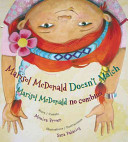
Marisol McDonald, a biracial, nonconformist, soccer-playing pirate-princess with brown skin and red hair, celebrates her uniqueness.
- ISBN: 9780892392353
- Illustrator: Palacios, Sara
- Published: 2011 , Childrens Book Press
- Themes: Culture, Family, Identity
- Descriptors: Awards, Bilingual, Intermediate (ages 9-14), Picture Book, Primary (ages 6-9), United States
- No. of pages: 32

Marie:
When I first read Marisol McDonald Doesn’t Match it struck me instantly as a book I wanted to read aloud with children. Marisol is an endearing character and the theme of individuality and not conforming to what others expect is a valuable discussion starter for all children. What I particularly enjoyed about Brown’s text though is how this theme is situated in the life of a bi-racial and bilingual child. I especially like not only the bilingual text in the book, but also how the Spanish language is woven into the English translation and even into the illustrations. I am not a Spanish speaker, so I also spent some time researching word meanings and pronunciations to perfect my readaloud of the book. I thought the notes in the afterword were particularly interesting, including the debate over which Spanish verb to use for the English word “match” as well as Brown’s insights into what inspired her to write the book.
Prisca:
Marisol McDonald Doesn’t Match is one of my favorite books! I agree with your insights! It’s a powerful story about being true to yourself and not trying to be like and “match” her friends. I recently read the book with several first grade classes and the children got the message right away. They talked about not trying to be like everyone else and just being who you are. They loved that Marisol picked out a dog that didn’t match and named the dog “Kitty”. They also quickly noticed and pointed out that Sara Palacios, the illustrator, used newspaper in places in her art and we talked about how maybe that was to make the art not “match” either. I too liked the bilingual text and how Spanish was woven into the text. I’m not a Spanish speaker either but a number of the children were. Those children helped me read the Spanish correctly (although I didn’t come close to pronouncing the words like they did!).
Marie:
That is a great point Prisca—when I taught secondary students who were Spanish speakers they were often quite involved with bilingual stories and would be the “expert” readers in the classroom who would help me (and other non-Spanish speakers) out as we experienced a text.
This book is a colorful and spunky celebration of individuality. And, it makes a great read aloud!
” My name is Marisol McDonald, and I don’t match. At least, that’s what everyone tells me”
“Me llamo Marisol McDonald y no combino. Al menos eso es lo que me dicen todos”
This is one of the newest books about a biracial child, Marisol Mcdonald. This book reminds us how often our identity is defined by others instead of our own internal definition of “who I am.” Often those others’ definition put us in a dilemma. “Matching” is explored in a wide range of contexts– color match in hair and skin/ match in shirts and pants/ peanut butter and jelly burritos, and finally her name Marisol and McDonald.
Despite everyone doubts or questions about mismatches on and around Marisol, Marisol’s creative and funky ideas around mismatch like yummy peanut butter burritos stays with her. It is not easy or straightforward to embrace who she really is at certain points. After she tries to “match” and suffers “unhappiness from the matching” experiences, she comes to realize her “mismatch” part is also part of her.
“My name is Marisol Mcdonald and I don’t match because… I don’t want to!”
A child’s agency is well illustrated through Mirasol’s journey to fit in and from her experience of unhappiness to be somebody else. Mirasol’s agency to choose and refuse exterior pressure to fit in ends with perfectly her new puppy that she chooses using her own criteria — mismatch.